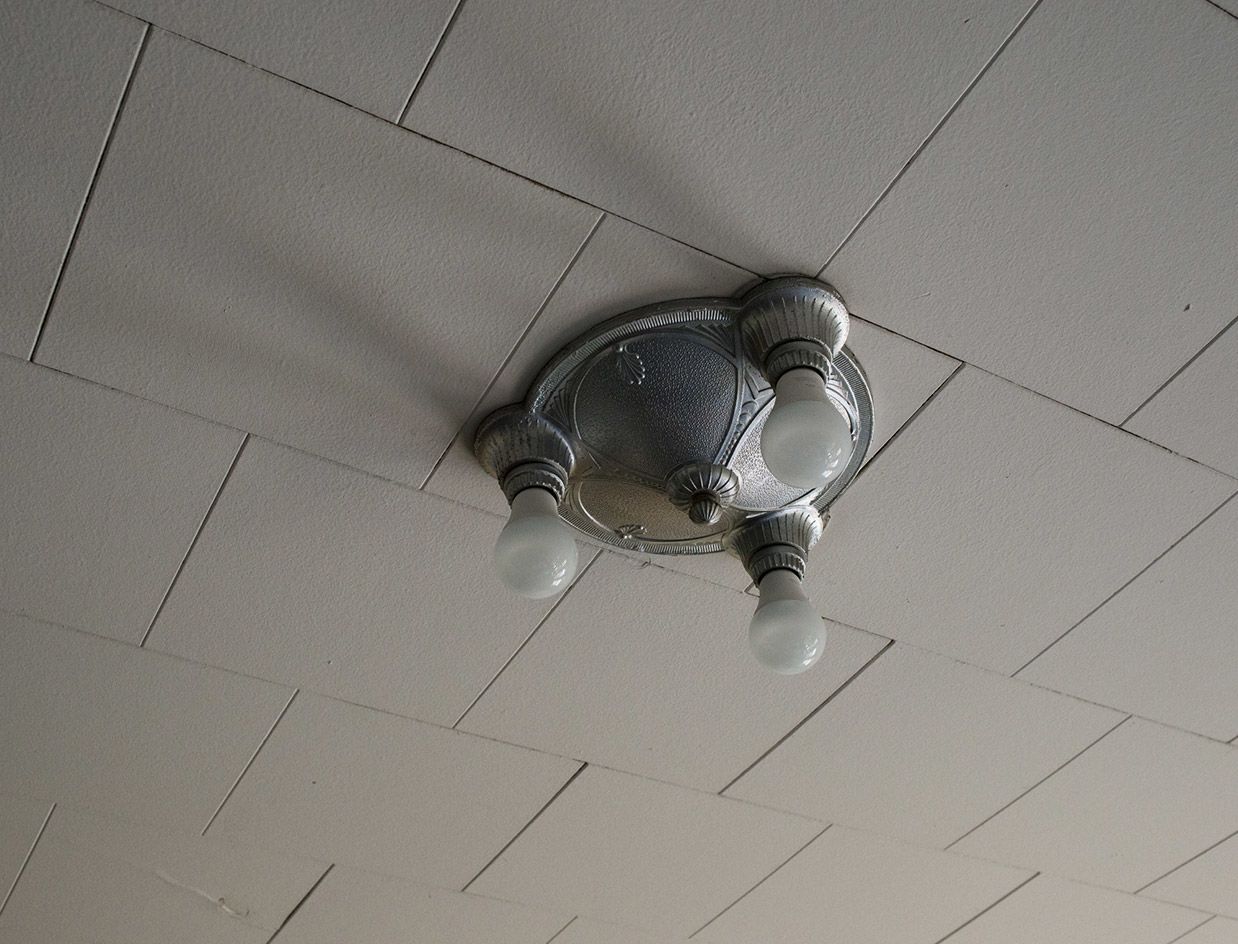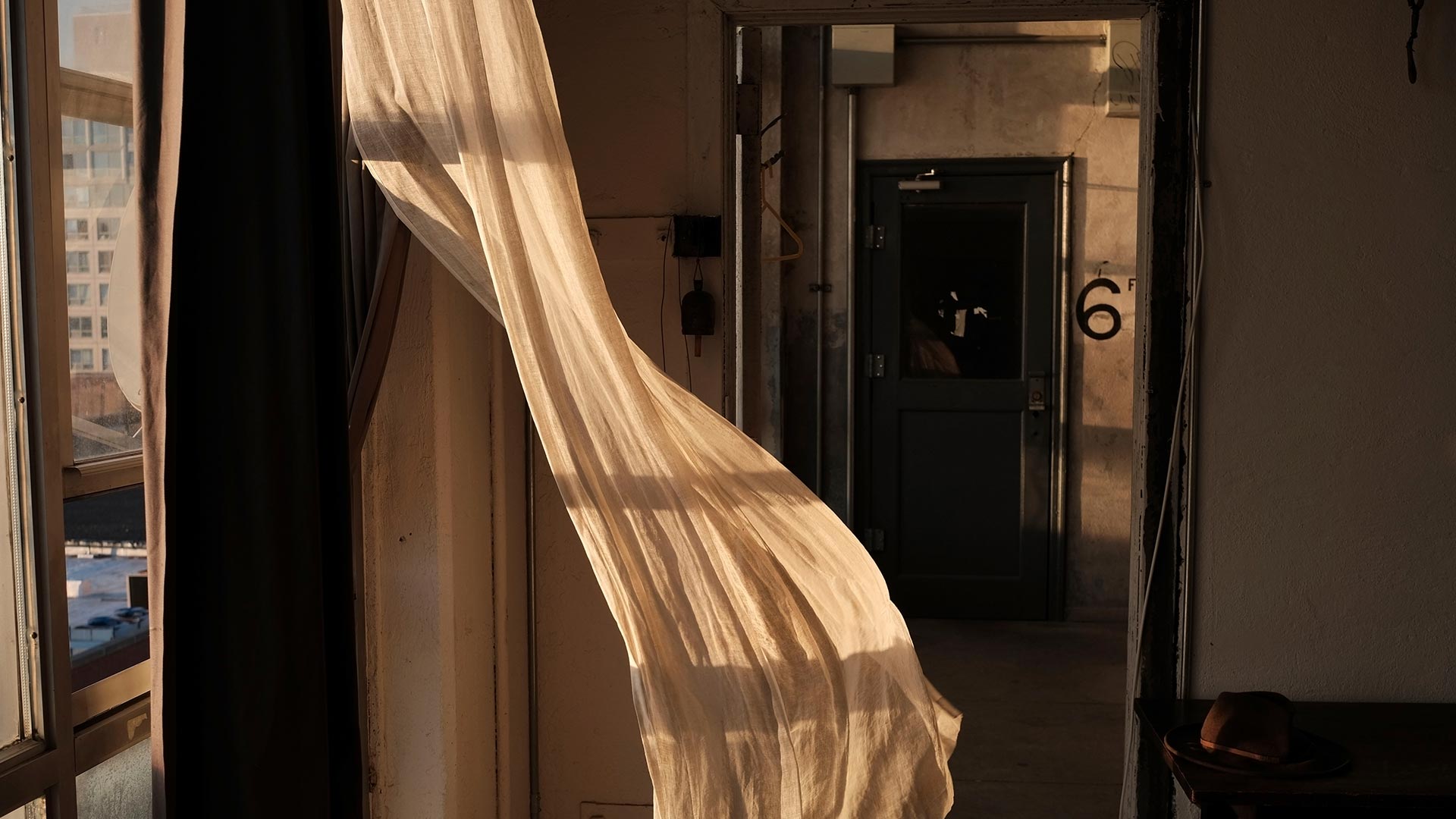When I heard the Duncan was closing, I booked a room right away—to make photographs, to pay homage, to have one last stay. Since the late 1980s, when I was a graduate student at Yale, I’ve been acquainted with the hotel and its reputation as a staging point for affairs, a storehouse of secrets. This time, I stay in Room 500, a suite with bay windows, a queen bed, and a foldout sofa. I’ve stayed in this room before and know well the Thomas Kinkade painting of a frosty mountain landscape that hangs above the bed, giving the whole room a dreamy and distant focal point. I’ve also stayed in Room 400, directly below, identical in layout but with a different palette and a distinct set of lamps and a muted, formerly emerald-green carpet. In every room, the veneer of luxury is thin, but the shabbiness is always specific. The Duncan was opened in 1895, and the wavering fortunes of New Haven have left the place exhausted. Lacy bathroom curtains are torn in places, linoleum tiles curl upward and crack, and the layers of paint on the window molding form a formidable impasto, much as with the Kinkade. I lie on my back in 500 and contemplate the drop-ceiling tiles, like an office’s. Steve, at the desk, is very nice about opening other rooms for me to photograph. I wonder if I’m the only hotel guest. This is not counting the long-term residents—thirty-eight of the ninety rooms provide low-income housing, but only seven of these residents are still living at the Duncan during my final stay. One man keeps popping out of his room, asking if I am the woman from the housing authority who is due to visit that day. AJ Capital Partners, a Chicago developer that plans to transform the Duncan into a modern boutique hotel, has hired an affiliate group of the Housing Authority of New Haven to help relocate these residents. Although the closure of the Hotel Duncan certainly tells a larger story of loss, change, and gentrification, I hesitate to tell that larger story as opposed to this smaller, more specific one. The Duncan speaks to me with its own grammar, vocabulary, syntax. Room 404—its number designated only with a sticky note—is plain compared with my suite: just a desk, a bed, a beige carpet. One of my favorites, Room 406, is entirely paneled in wood veneer, with two queen beds covered in matching flowered bedspreads. A floral painting hangs centered above a silver-painted radiator; bouquets of artificial flowers dot the room; the sunlight from the bay windows trickles in through sheer curtains and brushes the bureau, the walls, and the matching beds; a wire dangles from the ceiling, jerry-rigged to secure a pipe, and the ceiling cracks from the strain. It is the business of hotels to erase the traces of prior guests and create at least an illusion of freshness, of newness. But through time and inattention, the physical residue of the Duncan’s guests is felt and seen. Behind the bathroom door in Room 500, a single long hair lies coiled on the floor. The carpets have been crushed by countless steps. The four-poster bed is nicely made up but sags with the weight of all the bodies that have lain there. I suppose this should disgust me, the way it does so many online reviewers, but instead I find it stirring. In the old air of the rooms, presence and absence intermingle. The hotel easily calls to mind films like The Shining and The Tenant, though it is not so much horror as it is tragedy or melancholy that lurks here. Never mind the uncomfortable mattresses, the street noise, or the eerie interior sounds of walking and even crying; what makes sleep elusive is the unsettling feeling of cohabiting with the past. It is for this reason that when I have stayed here to visit my eldest daughter, herself now a student at Yale, and she—if she has fancied a sleepover—and her younger brother and sister and my husband have been able to find sleep, I find myself wandering the hotel at night, in communion with ghosts of a subtle, wan, discreet appeal. Now that the renovation is under way, countless dumpsters will brim with rolls of cigarette-saturated carpet, yards of damask curtains, ugly old pillows, brittle lampshades, and ripped-out wood paneling. What will happen to all the light fixtures, the bureaus, the mirrors, the cathode-ray TVs of the Duncan?
The Hotel Duncan


Tanya Marcuse, whose new series of monumental photographs, Woven, was on view at Julie Saul Gallery last fall in New York, is currently at work on early images which have not previously been exhibited.


